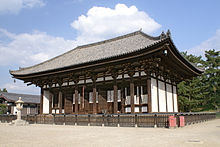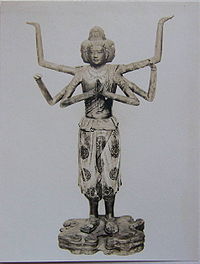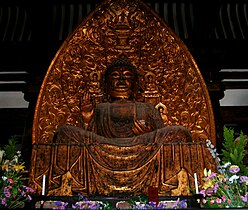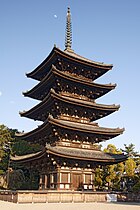| Kōfuku-ji | |
|---|---|
 Five-story pagoda and Tōkondō at Kōfuku-ji Five-story pagoda and Tōkondō at Kōfuku-ji | |
| Religion | |
| Affiliation | Hossō |
| Deity | Shaka Nyorai (Śākyamuni) |
| Location | |
| Location | 48 Noboriōji-chō, Nara, Nara Prefecture |
| Country | Japan |
| Geographic coordinates | 34°41′00″N 135°49′52″E / 34.68325°N 135.83117°E / 34.68325; 135.83117 |
| Architecture | |
| Founder | Emperor Tenji |
| Completed | 669 |
| Website | |
| www | |
Kōfuku-ji (興福寺, Kōfuku-ji) is a Buddhist temple that was once one of the powerful Seven Great Temples in the city of Nara, Japan. The temple is the national headquarters of the Hossō school.
History

Kōfuku-ji has its origin as a temple that was established in 669 by Kagami-no-Ōkimi (鏡大君), the wife of Fujiwara no Kamatari, wishing for her husband's recovery from illness. Its original site was in Yamashina, Yamashiro Province (present-day Kyoto). In 672, the temple was moved to Fujiwara-kyō, the first planned Japanese capital to copy the orthogonal grid pattern of Chang'an. In 710, the temple was dismantled for the second time and moved to its present location, on the east side of the newly constructed capital, Heijō-kyō, today's Nara.
Kōfuku-ji was the Fujiwara's tutelary temple, and enjoyed prosperity for as long as the family did. The temple was not only an important center for the Buddhist religion, but also retained influence over the imperial government, and even by "aggressive means" in some cases. When many of the Nanto Shichi Daiji, such as Tōdai-ji, declined after the move of capital to Heian-kyō (Kyoto), Kōfuku-ji kept its significance because of its connection to the Fujiwara.
The temple was damaged and destroyed by civil wars and fires many times, and was rebuilt as many times as well, although finally some of the important buildings, such as one of the three golden halls, the Nandaimon, Chūmon and the corridor were never reconstructed and are missing today. The rebuilding of the Central Golden Hall was completed in 2018.
Rokusō-an (六窓庵, Six Window Hut) was a chashitsu formerly located at the temple and considered one of the San-meiseki (三名席, Three Famous Tearooms). It was relocated due its deteriorated state and is now in the gardens of the Tokyo National Museum.
Architectures and treasures




The following are some of the temple's buildings and treasures of note.
Architecture
- East Golden Hall (東金堂, Tō-kondō), 1425, one of the former three golden halls (National Treasure)
- Central Golden Hall (中金堂, Chū-kondō), 2018, reconstructed, the former temporary Central Golden Hall building (仮金堂) now serves as the temporary Lecture Hall (仮講堂)
- Five-storied pagoda (五重塔, Gojū-no-tō), 1426 (National Treasure)
- Three-storied pagoda (三重塔, Sanjū-no-tō), 1185 (National Treasure)
- North Octagonal Hall (北円堂, Hoku'endō), 1210 (National Treasure)
- South Octagonal Hall (南円堂, Nan'endō), 1741, Site No.9 of Saigoku 33 Pilgrimage (Important Cultural Property)
- Bath House (大湯屋, Ōyūya), 1394–1427 (Important Cultural Property)
Treasures
- (Statue) The Devas of the Eight Classes, including dry-lacquer Ashura (National Treasure)
- (Statue) The Ten Great Disciples (National Treasure)
- (Statue) Thousand-armed Kannon (National Treasure)
- (Statue) Amoghapāśa (不空羂索観音, Fukūkensaku Kannon) attributed to Kōkei, is housed in Nan'endō (National Treasure)
Plan
Showing the original layout of the temple, with the later three-storied pagoda, Nan'en-dō, and Ōyūya superimposed. Of the buildings marked, only these three together with the five-storied pagoda, Tōkon-dō and Hoku'en-dō remain.
 Tōkondō
Three-storied pagoda
Five-storied pagoda
Hoku'endō
Nan'endō
Ōyūya
Kodō
Chūkondō
Saikondō
Chūmon
Nandaimon
Shōrō
Kyōzō
Kairō
monks' quarters
Tōkondō
Three-storied pagoda
Five-storied pagoda
Hoku'endō
Nan'endō
Ōyūya
Kodō
Chūkondō
Saikondō
Chūmon
Nandaimon
Shōrō
Kyōzō
Kairō
monks' quarters
|
Gallery
-
 Golden Buddha in Kōfuku-ji inside Tō-kondō
Golden Buddha in Kōfuku-ji inside Tō-kondō
-
 Yakushi Nyorai (Important Cultural Property) inside Tō-kondō
Yakushi Nyorai (Important Cultural Property) inside Tō-kondō
-
 Hoku'endō, older of the two octagonal halls
Hoku'endō, older of the two octagonal halls
-
 Gojū-no-tō five-storied pagoda
Gojū-no-tō five-storied pagoda
-
 Pagoda at night
Pagoda at night
-
 The Sanjū-no-tō stands behind Nan'endō
The Sanjū-no-tō stands behind Nan'endō
-
Gojū-no-tō five-storied pagoda from below
-
 Virūpākṣa
Virūpākṣa
-
 Rokusō-an tea house
Rokusō-an tea house
-
 Collection of statues
Collection of statues
-
 Collection of statues
Collection of statues
-
 Amida Nyorai
Amida Nyorai
-
 Kagenkei Gong
Kagenkei Gong
-
 Yuima Koji
Yuima Koji
See also
- List of National Treasures of Japan (archaeological materials)
- List of National Treasures of Japan (crafts-others)
- List of National Treasures of Japan (sculptures)
- List of National Treasures of Japan (temples)
- Siege of Nara
Sculptures formerly from Kōfuku-ji
- Boston Miroku - oldest sculpture made by the Busshi Kaikei, part of the temple's collection until 1906.
- Burke Jizō - sculpture by Kaikei, now a part of the Metropolitan Museum of Art
- Statue of Jizō (Intan) - another sculpture of Jizō, part of the MET.
Works of art from Kōfuku-ji
- The Final Death of the Buddha Sakyamuni - Nanboku-chō painting depicting Parinirvana (1320-1340)
Notes
- John Bowring, pp.218–219
- Turnbull, Stephen (1998). The Samurai Sourcebook. Cassell & Co. p. 200. ISBN 1-85409-523-4.
- Chado the Way of Tea: A Japanese Tea Master's Almanac, p. 163, at Google Books
- "Rokusoan Teahouse (Rokusoan) – the Magic of Japanese Masterpieces | NHK WORLD-JAPAN on Demand".
- "六窓庵とは".
- "Database of National Cultural Properties". Agency for Cultural Affairs. Retrieved 14 May 2011.
- "Database of National Cultural Properties". Agency for Cultural Affairs. Retrieved 14 May 2011.
- "Three-storied Pagoda National Treasure - KOHFUKUJI Temple". Retrieved 9 September 2023.
- "Database of National Cultural Properties". Agency for Cultural Affairs. Retrieved 14 May 2011.
- "Database of National Cultural Properties". Agency for Cultural Affairs. Retrieved 14 May 2011.
- "Database of National Cultural Properties". Agency for Cultural Affairs. Retrieved 14 May 2011.
- Suzuki, Kakichi (1980). Early Buddhist Architecture in Japan. Kodansha. p. 86. ISBN 0-87011-386-0.
- "Miroku, the Bodhisattva of the Future – Works – Museum of Fine Arts, Boston". 2021-05-30. Archived from the original on 2021-05-30. Retrieved 2024-02-17.
References
- John Bowring, Richard (2005). The religious traditions of Japan. Cambridge University Press. pp. 77–78. ISBN 0-521-85119-X.
- Noma, Seiroku; John M. Rosenfield; Bin Takahashi (2003). The Arts of Japan: Ancient and medieval. Kodansha International. pp. 84–85. ISBN 4-7700-2977-2.
External links
- Kōfuku-ji web site Archived 2019-12-29 at the Wayback Machine
- Kōfuku-ji web site(in Japanese)
- Kohfukuji Temple, from The Official Nara Travel Guide Archived 2019-12-28 at the Wayback Machine
- Nara Prefecture page on Kōfuku-ji Archived 2004-08-20 at the Wayback Machine
- UNESCO
- Exhibition of artifacts from Kofukuji reviewed in The Japan Times
| Historic Monuments of Ancient Nara | |
|---|---|
|
| Buddhist temples in Japan | |||||||||||||
|---|---|---|---|---|---|---|---|---|---|---|---|---|---|
| Japanese Buddhist architecture |
| ||||||||||||
| Schools and objects of worship |
| ||||||||||||
| Other elements |
| ||||||||||||
- Buddhist temples in Nara, Nara
- National Treasures of Japan
- World Heritage Sites in Japan
- Important Cultural Properties of Japan
- Pagodas in Japan
- Asuka period
- Historic Sites of Japan
- Maitreya
- Jingū-ji
- 669 establishments
- Religious buildings and structures completed in the 660s
- 7th-century Buddhist temples
- 7th-century establishments in Japan